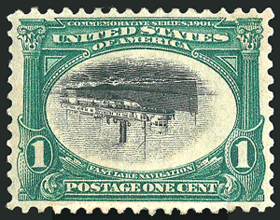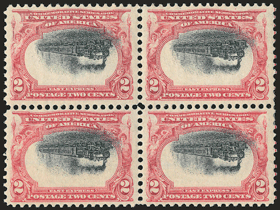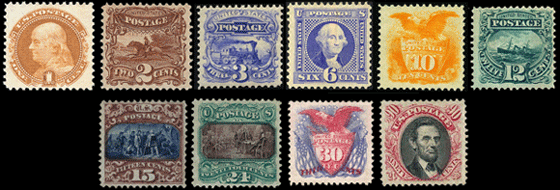|
Pan-American Inverted Stamp
Answer
to Name
This Famous Antique Game - July 2016
By Mike McLeod

In coin and stamp collecting, rarity is a key component of value, and oddities and mistakes can bring top dollar.
Virtually everyone is familiar with the Inverted Jenny stamp (the most recent sold for $1,175,000 at Robert Siegel Auctions in May of 2016), but there have been many more inverted stamps, and they are valuable.
|

|
Pan-American Inverted stamp
|
The stamp shown here is a 1-cent Pan-American Invert, issued in 1901 to commemorate the Pan-American Exposition held in Buffalo, N.Y. One-cent, 2-cent and 4-cent versions were printed inverted. In 2012, Robert Siegel Auctions sold three of the 1-center version for $6,250, $3,250 and $2,650, and Siegel auctioned a block of four in 2009 for $21,000. Prices have fluctuated greatly in past years; this stamp had been valued at $100,000 at one time.
|

|
This block of 2-cent Pan-American Inverts with a red background sold for $800,000. (Photo courtesy of Robert Siegel Auctions)
|
The theme of the Pan-American Exposition series was modes of transportation, and it featured an early automobile, a bridge, canal locks and a steam locomotive.1 The automobile and locomotive versions had an impressive showing in that same 2009 auction: a block of four 2-cent Pan-American Inverts of the train with a red background sold for $800,000, and a block of four 4-cent stamps featuring the automobile sold for $325,000. In 2012, a single of the locomotive sold for $12,000 at Robert Siegel Auctions. Bear in mind that completeness, quality and quantity of stamps greatly affect value.
After the first inverts of the ship and train were discovered, the four-cent automobile was deliberately printed inverted, reportedly through a miscommunication. Two sheets of 100 stamps each were printed, one with “Specimen” overprinted on it. These were placed in the postal archives, but later, some were traded for other rare stamps for the archives.2
The 1896 Pictorial Issue stamps were the first in U.S. postal history to be printed in two colors, which opened the door for inverts. In this series were depicted: the landing of Columbus, the signing of the Declaration of Independence, postal transportation (horseback, train and ship), George Washington, Abraham Lincoln, Benjamin Franklin and other designs.
|

|
|
The 1896 Pictorial Issue stamps (printed correctly).
|
Requiring two passes through the press to print them with two colors, some of the first sheets were reloaded wrong for the second pass. This yielded some sheets with inverted stamps—and eventually some great profits. In 2011, Robert Siegel Auctions sold a 15-cent Landing of Columbus, brown and blue in color, for $110,000. A 24-cent Signing of the Declaration of Independence, green and violet, went for $85,000.
You probably heard that the Post Office reissued the Inverted Jenny stamp in 2013 in a $2 denomination. Then, it announced that in addition to the 2.2 million sheets of Inverted Jenny stamps, it would also print 100 Non-Inverted Jenny stamps as souvenirs and distribute them randomly. In the end, only 20 sheets of the right-side-up plane were sent to post offices. Hmm.
In 2015, the Inspector General of the Postal Service ruled that creating this stamp was wrong because it had purposely created a rarity. In 2014, Robert Siegel Auctions sold a sheet of six of the Non-Inverted Jenny stamps for $45,000.
In 2006 and 2007, stampwants.com ran a promotion to give away an Inverted Jenny in a drawing from people who registered on their website. True to their word, they did give away an Inverted Jenny stamp in December 2007, and it was a successful promotion. However, the website no longer exists.
--------------------------
1 Hobbizine.com, “The Pan American Stamp Series of 1901 (#294-299).”
2 Stampactionnetwork.com, "The Alan B. Whitman Collection of Outstanding U.S. Stamps, Part Two: 1870-1901 Issues.”
3
Washingtonpost.com, “Postal Service’s reprinting of famous stamp error broke agency rules,” by Lisa Rein, July 21, 2015.
|